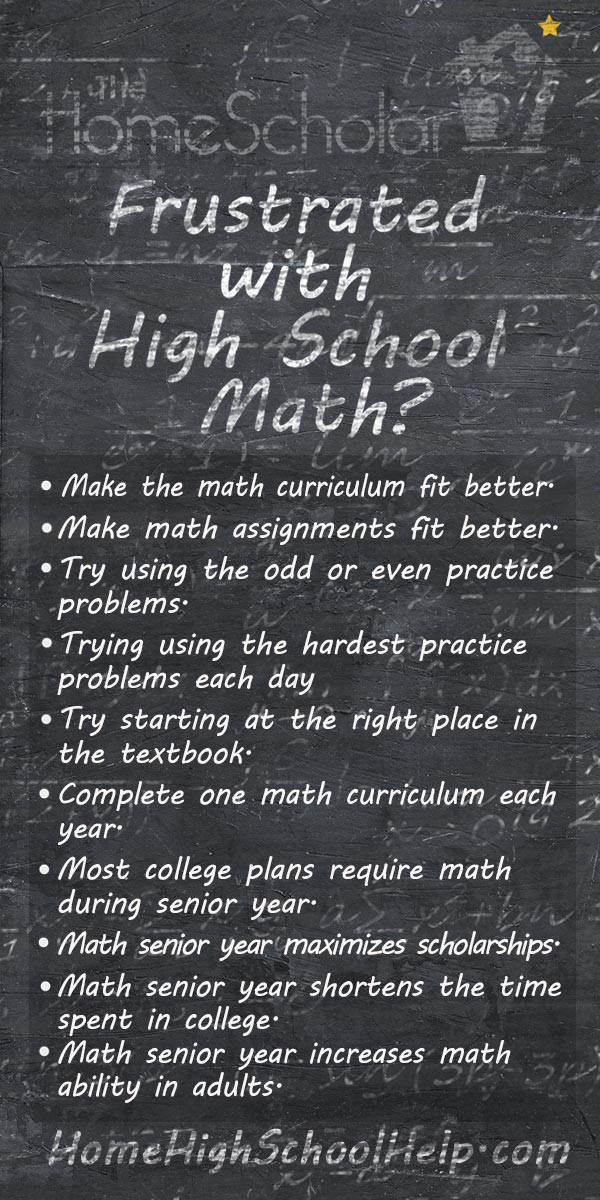Frustrated with High School Math?
Let's talk about frustration with high school math. As a home educator, you have the power to make things better. You can decide on the methods and curriculum that best fit your child. The best part of homeschooling is our ability to adapt. There are three things you can do when a student experiences frustration with math.
Step 1: Make your student's high school math curriculum fit them.
If your student is constantly frustrated with math, or has trouble finishing assignments, there may be a curriculum mismatch. While you can't make a student love math, you can make it palatable. If your student is doing well in math, but is frustrated, sometimes the child is just using a curriculum that doesn't fit. The blessing of homeschooling high school is that we have a variety of great math curricula to choose from. There are many great math programs that I love and work well. Look over this article, High School Math at Home, to help you choose between some of the top-rated programs.
Step 2: Make high school math assignments fit better.
Once you have chosen the curriculum that fits, decide if you should modify assignments. Each student needs a different number of practice problems before they learn the concepts. You aren't teaching a group of 30 students, you are only teaching one student. You can decide how many practice problems your one student needs. If a student is quite good at math, you could try reducing the number of practice problems to make the assignments fit better.
Try using the odd or even practice problems. Correct those problems. If the child gets 80%-90% correct, that's all the problems that are needed for mastery. After doing just half the practice problems your student could be done for the day. If the student does NOT get 80%-90% right, then he or she should do the other half of the problems. This option will sometimes work with perfectionists, or slow-as-molasses math nerds.
Trying using the hardest practice problems each day. With this option, assign just the last 5 or 6 problems in the practice set. Those are usually the hardest problems. If your student gets all of those 5 or 6 questions right, they probably don't need to practice on all the other easier problems. This option will sometimes work with gifted students who are working above grade level, or for those who really enjoy math.
Try starting at the right place in the textbook. When changing a math curriculum, you don't start over, no matter how much the publisher might say you need to buy all their books. Instead, you purchase the book you think he should start in, and then pre-test to determine WHERE in the book he should start. Like this: day 1, give end of chapter test 1. If he gets 80% correct, then day 2 you give the end of chapter test 2, and if he gets 80% right move on. Next day, day 3, you give him the end of chapter test 3, and if he gets 80% right the next day you give him the end of chapter test 4. Once you get to the chapter that he does NOT already know the answers to, then THAT is the chapter in the textbook you start to work on.
Step 3: Complete one high school math course each year.
Most college plans require math during senior year. Almost all colleges require 4 years of math taught in high school, even if the student is working at their level and never gets into calculus. Many colleges require that math be taken during senior year, even if the student is advanced in math. Having that math during senior year will keep your options open.
Taking math during senior year maximizes scholarships. Have your student complete a math course during senior year. With resistant teens, there may be a temptation to forego math during senior year, but don't give in to that temptation. Completing four years of math in high school will increase college admission chances. If the student has taken algebra before high school, and you include that on your high school transcript, you can even exceed expectations in math. That's a great position to be in, because you can maximize scholarships when you exceed expectations.
Taking math during senior year shortens the time spent in college. Doing math during senior year allows your student to stay fresh in their skills. At many universities, they require a placement test in math before students can register for college classes. Rusty math skills will produce a lower test score, and the student may have to take more math in college. Fresh math skills can make a huge difference in those placement tests, and help students to graduate college within four years.
Taking math senior year increases math ability in adults. If you have ever felt ill-prepared to teach high school math, could it be because your high school didn't prepare you in math? Even without college, students need math. It teaches critical thinking, and work ethic in jobs and life after college. While it's true we won't use all our math as adults, having the math in high school does help us to retain more math into adulthood.
I encourage parents to ensure four years of high school math, and a math level every year of high school. You can find additional reading on teaching math, if you have questions, in my article, 9 Ways to Actually Get Math Done This Year.
I hope that helps you as the home educator, and also maximizes your child's options for the future. Take care!

 Login
Login








.jpg)

Comments 2
Learning math can be a frustrating experience for both students and teachers. When teaching math, creativity should be used to make the material interesting and engaging for students. There are many different ways to teach math, and the approach that works best for one student may not work for another. Some students may prefer hands-on activities, while others may prefer more traditional methods of instruction. It is important to find what works best for each student and to be flexible in order to help them succeed.
The are wonderful points! Finding what the student needs will give them the best chance at learning math well.
Blessings ~
Jennifer, Assistant to Lee